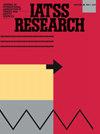Measuring road safety performance and culture: A comparative study of 39 countries
IF 3.3
Q3 TRANSPORTATION
引用次数: 0
Abstract
Monitoring of road safety performance is essential to effectively address the global road safety problem. Consistent and accurate monitoring allows policymakers to assess the effectiveness of current safety measures, identify emerging risk factors, and develop targeted interventions. Different key performance indicators can be used to monitor road safety performance. In addition to the traditional road safety indicators based on the number of fatalities or injured people in road traffic crashes, complementary road safety performance indicators can be used in relation to vehicles, infrastructure or road users' behaviour.
The E-Survey of Road Users' Attitudes (ESRA) is an online survey that aims to collect and analyse comparable data on road safety performance and traffic safety culture across the world. In its three editions (from 2015 to 2023) ESRA has included data from more than 120,000 road users from a total of 68 different countries. This paper focuses on data from the third edition of the ESRA survey (ESRA3), which was conducted in 2023 across 39 countries and includes answers from over 37,000 road users. The objectives are to provide an overview of the ESRA3 survey methodology and to present results related to several road safety topics, such as drink-driving, speeding, or distraction, across different types of road users: car drivers, pedestrians, cyclists, and moped riders/motorcyclists. It examines multiple dimensions of risky behaviours in traffic, including self-declared behaviours, personal acceptability of unsafe behaviours, and support for policy measures.
Results show low acceptability of unsafe traffic behaviours like speeding, drink-driving, fatigued driving or using a mobile phone while driving a car – less than 5 % of respondents considered these behaviours acceptable. Notwithstanding the low acceptability, a high percentage of car drivers declared engaging in risky behaviours in traffic: speeding within built-up areas was declared by 37 % to 47 % of car drivers, using a mobile phone by 22 % to 32 %, fatigued driving by 18 % to 20 %, and driving under the influence of alcohol by 10 % to 14 %. As for vulnerable road users, distraction (reading messages/checking social media or listening to music through headphones) was the most declared risky behaviour by pedestrians, the non-use of helmet the most declared by cyclists, and speeding the most declared by moped riders and motorcyclists. Most respondents support policy measures to restrict risky behaviour.
The ESRA survey offers a unique database and provides policy makers and researchers with valuable insights into public perception of road safety.
衡量道路安全绩效与文化:39个国家的比较研究
监测道路安全绩效对于有效解决全球道路安全问题至关重要。一致和准确的监测使决策者能够评估当前安全措施的有效性,确定新出现的风险因素,并制定有针对性的干预措施。不同的关键绩效指标可用于监测道路安全绩效。除了基于道路交通碰撞死亡或受伤人数的传统道路安全指标外,还可以使用与车辆、基础设施或道路使用者行为相关的补充性道路安全绩效指标。道路使用者态度电子调查(ESRA)是一项在线调查,旨在收集和分析世界各地道路安全表现和交通安全文化的可比数据。在2015年至2023年的三个版本中,ESRA包含了来自68个不同国家的120,000多名道路使用者的数据。本文重点关注第三版ESRA调查(ESRA3)的数据,该调查于2023年在39个国家进行,包括来自37,000多名道路使用者的回答。目的是提供ESRA3调查方法的概述,并介绍与几个道路安全主题相关的结果,如酒后驾驶、超速或分心,涉及不同类型的道路使用者:汽车司机、行人、骑自行车的人和骑轻便摩托车的人/摩托车手。它考察了交通危险行为的多个维度,包括自我声明的行为、个人对不安全行为的接受程度以及对政策措施的支持。调查结果显示,超速、酒驾、疲劳驾驶或开车时使用手机等不安全交通行为的可接受性较低——只有不到5%的答复者认为这些行为是可接受的。尽管可接受性很低,但有很高比例的汽车司机声称在交通中有危险行为:37%至47%的汽车司机声称在建筑区内超速,22%至32%的汽车司机声称使用手机,18%至20%的汽车司机疲劳驾驶,10%至14%的汽车司机在酒精影响下驾驶。对于易受伤害的道路使用者来说,行人认为分心(阅读信息/查看社交媒体或通过耳机听音乐)是最危险的行为,骑自行车的人认为不戴头盔是最危险的行为,骑轻便摩托车和骑摩托车的人认为超速是最危险的行为。大多数受访者支持限制风险行为的政策措施。ESRA的调查提供了一个独特的数据库,为政策制定者和研究人员提供了有关公众对道路安全看法的宝贵见解。
本文章由计算机程序翻译,如有差异,请以英文原文为准。
求助全文
约1分钟内获得全文
求助全文
来源期刊

IATSS Research
TRANSPORTATION-
CiteScore
6.40
自引率
6.20%
发文量
44
审稿时长
42 weeks
期刊介绍:
First published in 1977 as an international journal sponsored by the International Association of Traffic and Safety Sciences, IATSS Research has contributed to the dissemination of interdisciplinary wisdom on ideal mobility, particularly in Asia. IATSS Research is an international refereed journal providing a platform for the exchange of scientific findings on transportation and safety across a wide range of academic fields, with particular emphasis on the links between scientific findings and practice in society and cultural contexts. IATSS Research welcomes submission of original research articles and reviews that satisfy the following conditions: 1.Relevant to transportation and safety, and the multiple impacts of transportation systems on security, human health, and the environment. 2.Contains important policy and practical implications based on scientific evidence in the applicable academic field. In addition to welcoming general submissions, IATSS Research occasionally plans and publishes special feature sections and special issues composed of invited articles addressing specific topics.
 求助内容:
求助内容: 应助结果提醒方式:
应助结果提醒方式:


